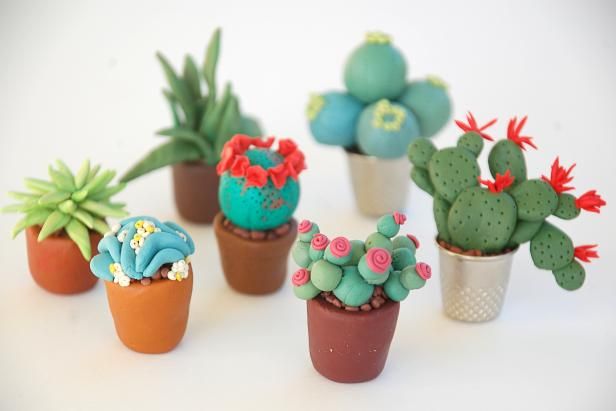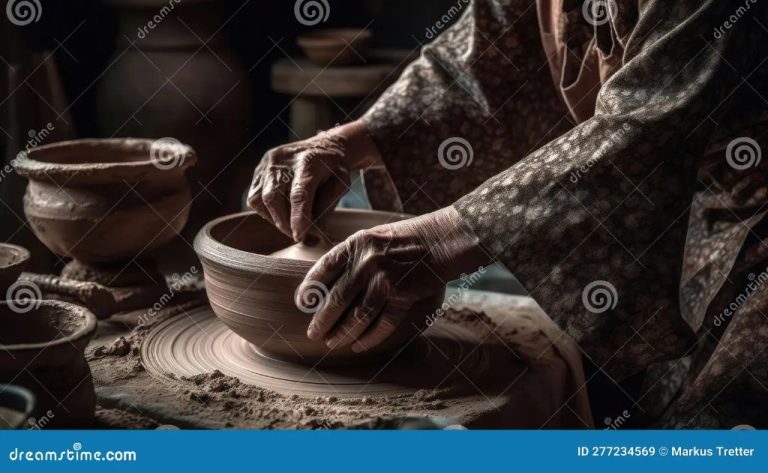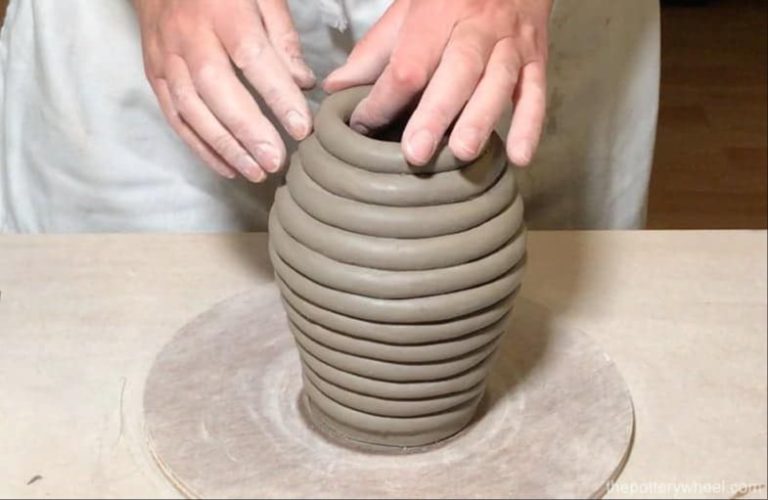Can You Bake Regular Clay In A Regular Oven?
Regular clay refers to natural clays that are used for pottery and ceramics, such as earthenware clay, stoneware clay, and porcelain clay. These clays are composed of natural minerals like kaolinite and clay particles that give clay its plasticity. Regular clay is different from specialized polymer clays that already include binders and harden at lower temperatures.
A regular oven is a standard kitchen appliance used for baking and roasting food. Most home ovens are designed to reach maximum temperatures between 450-550°F (230-290°C). Regular ovens do not typically reach the high temperatures that a kiln used for pottery can, which is usually over 1000°F (540°C).
Can You Bake Regular Clay in a Regular Oven?
Yes, you can bake many types of regular clay in a regular home oven. Clays like polymer clay, air-dry clay, and natural clays can all be hardened through baking in a standard oven (1). The key factors are ensuring the oven can reach and maintain the proper temperature, and monitoring the bake time and temperature closely. With the right preparation and care, baking clay in a standard oven can produce high quality finished pieces.
Polymer clays like Sculpey are specially formulated for home baking. According to the Sculpey website, all Sculpey brands can be hardened in home ovens at temperatures from 275°F to 325°F (2). Air-dry clays like Crayola Model Magic can also be hardened in a home oven to cure pieces faster. Natural clays like potter’s clay require higher temperatures of at least 1,832°F (1,000°C), so they may require a kiln rather than a basic home oven (1).

Overall, many standard clays can be successfully baked at home as long as the proper temperatures, bake times, and cooling procedures are followed. With care and preparation, a regular oven can produce durable, high quality finished clay pieces.
Sources:
(1) https://www.quora.com/Can-I-bake-pottery-clay-in-a-regular-oven
(2) https://www.sculpey.com/faq
Temperature Requirements
To successfully bake regular clay in a home oven, it is important to know the right temperature range. According to Oy-Tra, most clays should be baked between 230°F (110°C) and 265°F (130°C) for the best results. Baking at too low of a temperature can make the clay brittle. Sculpey recommends baking polymer clay at 275°F. In general, a temperature range of 230-275°F (110-135°C) will work for baking regular clay in a standard home oven.
It’s important to refer to the manufacturer’s instructions for the specific type of clay being used, as the optimal temperature can vary. Baking clay at the proper temperature for the recommended time will result in durable, hardened clay with the desired characteristics.
Preparing the Clay
Before baking regular clay in the oven, it’s important to properly condition and prepare the clay. Most clays will benefit from some kneading and conditioning before baking. This makes the clay smoother and easier to work with. According to the Sculpey website, you should “condition your clay by kneading and rolling until soft and pliable.”
When conditioning the clay, make sure your hands and work surface are clean so you don’t get any debris or dust stuck in the clay. Knead the clay vigorously with your fingers until it becomes soft, smooth, and elastic. The warmth and pressure from your hands will help condition the clay.
After kneading, you may want to run the clay through a pasta machine to create an even sheet of clay without air bubbles. Set the pasta machine to the thickest setting first and run the clay through the rollers. Fold the clay in half and run it through the rollers again. Continue running it through progressively thinner settings until you achieve the desired thickness.
If your clay project requires multiple pieces or colors, make sure to properly blend pieces together. To adhere clay surfaces, add a drop of liquid clay or lightly scratch the surfaces before pressing them together firmly. Avoid trapping air bubbles between layers.
Once your clay is conditioned and your project is formed, you are ready to bake it in the oven. Make sure your clay is no thicker than 1/4 inch before baking, as thicker pieces may crack or underbake in the center.
Baking Instructions
When baking regular clay in a regular oven, follow these step-by-step instructions for best results:
- Preheat the oven to 275°F.
- Place the clay sculpture on a cookie sheet or baking tray lined with parchment paper.
- Bake the clay for 15 minutes for every 1/4 inch of thickness. For example, if the thickest part of your sculpture is 1 inch thick, bake it for 60 minutes (15 minutes x 4).
- Check the clay periodically during baking. Bake until the clay has hardened completely.
- Avoid opening the oven door frequently, as this can cause cracks or under-baking.
- Allow the clay to cool completely before handling. Cool for at least 30 minutes.
Tips for baking clay in an oven:
- Support pieces of the sculpture with aluminum foil or clay stilts to prevent flattening or drooping.
- Bake clay on the center rack in the oven for the most consistent heat.
- Do not bake clay at temperatures above 275°F, as it may scorch or burn.
- Underbake rather than overbake if unsure. Clay can be returned to the oven if still soft after cooling.
With the proper preparation, regular oven baking can produce smooth, hardened clay suitable for any sculpting project. Monitor closely and adjust time or temperature as needed based on the clay brand and your oven.
Source: https://spinningpots.com/how-to-fire-pottery-in-your-oven/
Cooling and Curing
Properly cooling and curing your baked clay is a crucial step for achieving durable, long-lasting finished pieces. According to the Cool Tools guide on curing polymer clay, you should allow your clay to cool completely inside the oven first with the oven door slightly propped open. This prevents drastic temperature changes that could cause cracks or breakage.
Once cooled to room temperature, the recommended curing time is 24 hours before touching or handling the piece. This gives the clay time to fully harden and cure, ensuring it reaches maximum strength and durability. Sculpey’s guide recommends allowing pieces to cure for at least 24 hours before applying any paint, varnish, or finishing touches.
According to The Polymer Clay Expert, cooling baked clay at room temperature overnight is ideal, as this allows trapped heat from baking to fully dissipate. For thin pieces under 1/4 inch thick, 12 hours of curing may be sufficient. Thicker pieces need longer – up to 3 days of curing time if over 1 inch thick. Allowing adequate cooling and curing prevents later issues like cracking or paint peeling off.
Common Problems
There are some common issues that can arise when baking clay in a regular kitchen oven:
Uneven heating – Since regular ovens are not designed specifically for baking clay, they tend to have hot spots which can lead to uneven baking. This may result in some areas being undercooked or overcooked (https://www.sculpey.com/blogs/blog/6-things-to-avoid-when-baking-polymer-clay). To mitigate this, rotate the clay halfway during baking.
Burning or scorching – If placed too close to the heating element, clay can easily burn or scorch. Leave at least 1-2 inches between the clay and heating coils or flames (https://www.sculpey.com/blogs/blog/6-things-to-avoid-when-baking-polymer-clay). You may need a baking sheet or aluminum foil to create a buffer.
Cracking – Rapid temperature changes can cause cracking in baked clay. Allow the oven and clay to heat up gradually and cool down slowly. Cracking can also occur if clay is under-conditioned before baking.
Baked on food residue – Any food splatters or grease inside the oven can bake onto the clay, leaving burnt marks. Ensure the oven interior is completely clean before baking clay.
Fumes – Some clays release unpleasant odors or fumes when baked. Open windows and turn on exhaust fans for ventilation.
Safety Tips
When baking polymer clay in a regular kitchen oven, it’s important to take precautions to prevent burning or overheating the clay and oven. Here are some tips for safely baking clay:
Ventilate the kitchen – Open windows and turn on exhaust fans to allow fumes to escape. Avoid breathing in polymer clay fumes as they can be toxic.
Keep temps low – Bake clay at the manufacturer’s recommended temperature, usually between 110°C and 130°C max. Excessive heat can scorch or burn the clay. Monitor the oven temp with an oven thermometer.
Use foil or an oven liner – Cover oven racks with foil or a silicone baking mat to prevent clay from sticking and baking onto the racks. This also helps protect the oven.
Allow space for airflow – Don’t overcrowd the oven with too many clay pieces. Leave space between items so heat can properly circulate.
Watch closely – Stay close by as the clay bakes in case you need to turn pieces or remove them if overbaking. Never leave clay unattended in the oven.
Cool properly – Turn off the oven and allow pieces to cool down gradually inside to prevent cracking or warping.
Alternative Methods
While the oven is the most common method for baking polymer clay, there are some alternatives if you don’t have access to a regular oven or need to harden small amounts of clay:
Heat guns and hair dryers can be used to cure polymer clay. Set the heat tool to the manufacturer’s recommended baking temperature and wave it back and forth over the clay slowly to heat it evenly. Be aware that this can take significantly longer than baking in an oven.[1]
Small pieces of polymer clay jewelry or charms can be hardened using a low temperature heat embossing tool. Carefully heat the clay according to the tool’s instructions to fully cure it.[1]
“Oven-hardening” or “air-dry” polymer clays do not require baking and will cure at room temperature over 24-48 hours.[2] However, they may not achieve the same hardness and durability as polymer clays cured in the oven.
While sunlight and UV lamps can potentially cure polymer clay, results are unreliable. Oven baking remains the recommended method for even and thorough hardening.[3]
Conclusion
To summarize, regular clay can be baked in a regular oven if certain precautions are taken. The key things to keep in mind are:
- Preheat the oven to the proper temperature according to the clay instructions, usually between 200-300°F.
- Place clay on a cookie sheet or baking dish lined with parchment paper or aluminum foil.
- Avoid baking multiple pieces stacked together, which can prevent even heating.
- Bake for the recommended time, checking periodically to prevent over-baking.
- Allow the clay to cool slowly inside the oven before handling to prevent cracking.
- Once cooled, the clay may require further curing time to fully harden before use.
With the right preparations and cautions, regular oven baking can produce high quality clay creations safely and conveniently at home.



